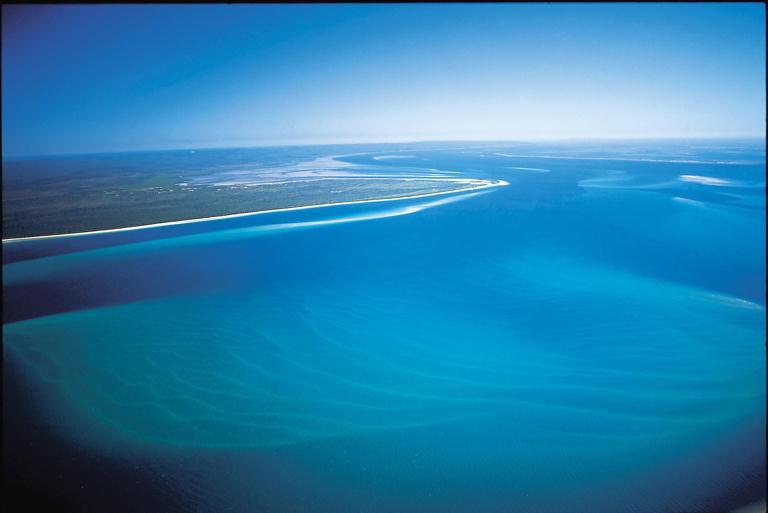Wonga Park, Victoria, Australia
Suggest Place to Visit
880
Track to location with GPS |
 |
The British explorer James Cook discovered the island on May 29, 1770. He circled it on the eastern side, assuming that it was only a promontory. He gave names to the riverside areas that he was exploring. Indian Head, is a cliff to the northeast of the island. He gave it this name because the aborigines met there upon their arrival. Sandy Cape forms the tip of the island. Today there is a lighthouse there that warns the boats that the waters are dangerous.
On the night of May 22, 1836, the ship Stirling Castle was wrecked on the Great Barrier Reef, a few hundred kilometers north of Fraser Island. Eighteen people were on board, including Captain James Fraser and his wife Elizabeth.
They launched a rescue boat for the crew, and the captain and his wife took another rescue boat that was towed by the crew.
According to Elizabeth Fraser's stories, the castaways landed near Waddy Point, where they went in search of fresh water. All of them were captured by aborigines who allegedly kept them in captivity for several weeks. The aborigines also forced them to work for them. Captain Fraser fell ill and was unable to work, was wounded by a spear and succumbed to his wounds eight or nine days later. But according to another survivor the captain died a natural death. It is also said that the aborigines would have rescued the crew.
Elizabeth Fraser survived and was, along with other survivors, rescued by a relief patrol that arrived from Brisbane. She was able to return to England in 1837, and thanks to her talents as a storyteller, her story was sold in every London bookstore. The sufferings of Captain Fraser and his wife Elizabeth became legendary and gave the island its name. Her story also inspired the famous Australian writer Patrick White's novel: A Belt of Leaves. However, these stories have met with great hostility among Aborigines across Australia. Elizabeth Fraser later died in Melbourne, hit by a float.
The surrounding inhabitants began to visit the island in the 1870s. But tourism did not develop on Fraser Island until 1930 with the organization of the first commercial center of tour operators and the organization of the first visits. Tourism grew throughout the 20th century. In 1970, the island became a major destination off the Queensland coast. In 1992, the island became part of Great Sandy National Park. Since 1976, the forests were declared property of the State.
In the 1950s, Australian authorities launched a plan to transfer the population of Nauru, an overpopulated island heavily affected by phosphate mining, first to Fraser Island and then to Curtis Island. This project was unsuccessful and finally it was rejected in 1964 because of the refusal of Australia to the independence of the Nauru inhabitants who would have to be content with an autonomy in the Commonwealth of Australia.
Today, the development of tourism, preserving the charm and biodiversity of the island has become the challenge of the authorities. On the island, tourists are aware of the fragility of a unique ecosystem. The maintenance of this attraction depends on its compliance with basic rules such as the prohibition of feeding the dingoes. The cohabitation of men and dingoes is, indeed, subject to considerable controversy. On April 30, 2001, a nine-year-old boy was attacked and killed by dingoes on Fraser Island. It was the first case of a fatal attack on a human being over a year old by dingoes in Australia. 31 dingoes used to frequenting tourist areas were slaughtered. Some spoke of euthanizing everyone, even though dingoes are on the endangered species list. The message given to tourists is this: if Fraser Island is to remain open to the public, we must be aware that our presence must be as less visible and as least disruptive as possible.
Fraser Island is the largest Sand Island in the world, and known to most of Queensland as simply Fraser. The island is more than 120 km long by 15 km wide. Part of the Island is known as Great Sandy National Park. Fraser Island has sand dunes that can reach 180 meters high, as most of the island is covered by thick vegetation that is home to many birds and marsupials. The island is on the World Heritage list. It is truly spectacular and should not be missed!
Comments
We don´t have yet any comments about:
Fraser Island overview
Fraser Island overview
Be the first to leave a comment as it is very important to inform other people
Outros locais a visitar
Within a radius of 20 km from:Fraser Island overview
Unfortunately we do not have information on other places to visit in this area yet
Hotel reservation near Fraser Island overview within a radius of 20 km
No results
Why to book with ROTAS TURISTICAS
The best prices
Our partnerships with the world´s largest operators offer research on the best market prices.
More options
At Rotas Turisticos you can book the hotel, buy the air ticket, book the transfer from the airport to the hotel and vice versa, book the local excursions, rent the car, take travel insurance and consult the places to visit and where to go.
Holiday Tips & Destinations
Hundreds of holiday destinations with all the options that allow you to easily choose the destination that best suits your dream vacation.
ROTAS TURISTICAS
Links





